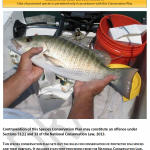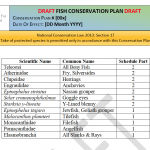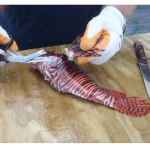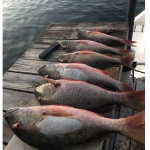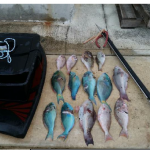Notice of Public Consultation: Cayman Islands Fish Conservation Plan
 The National Conservation Council invites public comment on a Species Conservation Plan for Fish. The Plan may be viewed at www.DoE.ky/fish-conservation and at the Grand Cayman Department of Environment office, District Libraries and the Little Cayman DoE Building. Written submissions should be sent to ConservationCouncil@gov.ky or to the Conservation Council, c/o Department of Environment, PO Box 10202, KY1-1002, Grand Cayman, Cayman Islands, or by hand to the Department of Environment office, 580 North Sound Road, Grand Cayman, Cayman Islands. Submissions must be received by 19 August 2016.
The National Conservation Council invites public comment on a Species Conservation Plan for Fish. The Plan may be viewed at www.DoE.ky/fish-conservation and at the Grand Cayman Department of Environment office, District Libraries and the Little Cayman DoE Building. Written submissions should be sent to ConservationCouncil@gov.ky or to the Conservation Council, c/o Department of Environment, PO Box 10202, KY1-1002, Grand Cayman, Cayman Islands, or by hand to the Department of Environment office, 580 North Sound Road, Grand Cayman, Cayman Islands. Submissions must be received by 19 August 2016.
1. Species Concerned:
a. All Fish
2. Proposed Conservation Measures:
a. Parrotfish bag limit: 3 per person per day
b. Parrotfish size limit: no smaller than 12 inches, no larger than 24 inches
c. Goggle eyes, sprats, fries bag limit: half of a five-gallon bucket per person per day
d. No sale or purchase of fish taken with a spear gun, except lionfish.
e. To not encourage commercial fishing, except for lionfish, as local stocks are inadequate to meet local demand.
3. Existing Conservation Measures
a. No take of any Part 1 species, or y-lined blennies, without a permit or licence.
b. Part 2 species may be taken without a permit or licence except as otherwise specified in this or another Species Conservation Plan, or in Regulation.
c. Nassau grouper take only as allowed by Regulation. d. No take of any fish less than 8” long, except
e. Goggle eyes, sprats, fries, lionfish
f. No take of any fish species with a spear gun, net or fish pot without a licence.
g. No fish may be fed as a form of wildlife interaction except as allowed within a Wildlife Interaction Zone (WIZ).
h. No taking fish (any marine life)
on SCUBA (except lionfish).
4. Critical Habitat a. None
PROTECTION MEASURES & CRITICAL HABITAT
1) Regulation of Take
a) No take of any part 1 species, without a permit or licence.
b) Part 2 species may be taken without a permit or licence except as otherwise specified in this or another Species Conservation Plan.
c) No take of Epinephelus striatus, Nassau grouper, except as allowed by regulation, permit, licence or under an Epinephelus striatus, Nassau grouper, species conservation plan.
d) No take of Starksia y-lineata, Y-Lined blenny, without a permit or licence.
e) No take of Teleostei below 8 inches in length, except i) lionfish (Pterois spp.)
ii) goggle eyes, herring, anchovies, silversides f) Parrotfish, (family: Scaridae)
i) No more than three may be taken by any one person in any one day ii) No take of fish smaller than 12 inches, of longer than 24 inches
g) No more than half of a five-gallon bucket may be taken by any one person in any one day of the following species:
i) Atherinidae – Fry, Silversides ii) Clupeidae – Herrings
iii) Engraulidae – Anchovies
iv) Selar crumenophthalmus – Goggle eyes
2) Fisheries Licences
a) No take of any fish species with a spear gun, net or fish pot without a licence.
3) Additional Conservation Measures
a) No fish may be fed as a form of wildlife interaction except as allowed within the regulations or management plan of a designated Protected Area.
b) No sale or purchase of fish taken with a spear gun, except lionfish (Pterois spp.)
c) No taking any marine life on SCUBA
d) Protected Area regulations
e) Licensing or Permit conditions
f) It is the policy of the Cayman Islands Government to discourage commercial fishing, except of lionfish (Pterois spp.), as local stocks are inadequate to meet local demand.
4) Critical Habitat
a) There is no Critical Habitat identified for fish, at this time, within the Cayman
Islands.
SPECIES SUCCESS CRITERIA & COST ESTIMATES
17. (3) (a) (i)
Goliath Grouper: Down-listing from Critically Endangered to Least Concern, using IUCN Red List criteria
Elasmobranchs: All elasmobranchs present in Cayman Waters judged IUCN Least
Concern
Tile Fish, File Fish & Angel Fish: protected primarily for their attractiveness as ornamental reef fish, therefore down listing criteria cannot be estimated accurately.
17. (3) (a) (ii)
The estimated time required to carry out these measures cannot be estimated accurately.
The costs involved to carry out these measures: Estimated to be $200,000 per year for research and enforcement activities aimed towards achieving sustainable fish populations and fisheries in the Cayman Islands.
EXEMPTIONS FROM THIS LAW
For the purposes of research the Department of Environment, employees, agents and volunteers, may take protected species.
Permits may be issued to take protected species for research and monitoring purposes.
Explaining the draft Species Conservation Plan for Fish
1) Why this plan now?
a) The National Conservation Law requires that users of spear guns, fish pots and nets be licensed. Licences issued under the Law are for the take of species managed through Species Conservation Plans. Therefore in order to allow the Council to licence fish pots, etc.,
the Council passed an interim directive to allow them to do so. “The take of any of the fish species listed in Schedule 1 Part 1 and Part 2 of the National Conservation Law, 2013 with a spear gun, seine net, gill net or fish pot is prohibited without a licence.”
b) Interim directives are temporary measures and should be replaced by full Species Conservation Plans. This Plan will replace the interim Directives issued by the Council.
2) How does the consultation work?
a) The Plan has been advertised and is posted on the Department of Environment website and in all of the district libraries. (In Little Cayman it is posted at the Department of Environment building.) It is also at the Department of Environment office in Grand Cayman and anyone with questions can come in (call ahead) or better yet email DoE@gov.ky.
b) The public have until August 19th to provide written feedback to the Council: ConservationCouncil@gov.ky. (Letters can also be mailed or delivered to the Department of Environment for the Council.)
c) The Council then reviews all submissions and decides whether to change the Plan, carry out more consultation, or send it to the Cabinet.
3) Will there be public meetings?
a) No. This Plan does not propose very significant changes. For the most part existing rules and regulations have been restated, but now under the National Conservation Law.
b) Anyone who has a question is encouraged to email (DoE@gov.ky), call
(949-8469) or come in to the DoE (on Grand Cayman). The Department is happy to talk with anyone about any questions or issues they may have about the proposed Plan.
4) What old rules does the plan bring forward?
a) That the protected species, like goliath grouper, sharks and rays, are all still protected, as are any fish smaller than 8”. (Except goggle eyes, sprats and fries of course.)
b) That other species aren’t protected unless there are specific rules for them.
c) No taking of fish on SCUBA, no fish-feeding outside of Wildlife Interaction Zones, and of course no taking fish with a fish pot, spear gun or net without a licence.
5) Will this plan change the spear gun licencing rules?
a) No.
b) The only change is that people can’t spear fish commercially, i.e. spear fish for sale.
6) What about lionfish?
a) There is almost always an exception for lionfish. Many of these new rules expressly mention, and exclude, lionfishing. In other cases the exclusions are in the lionfish permits themselves, or in the other licences or permits which people will receive.
b) We want to encourage people to fish for lionfish, including fishing for them commercially, and the
Plan accommodates this.
7) What about other commercial fishing?
a) Our local marine resources cannot support commercial fishing, i.e. fishing on a large scale to satisfy total consumption by locals and visitors alike. Our coastal shelf, the productive waters around each of our Islands, is
too small to produce the amount of fish we would need.
b) If local fishermen choose to sell their
excess catch the plan accommodates this.
c) It is important to recognise that proposed catch limits are designed around recreational fishers who only take their limit occasionally. Even these proposed limits would be too high for daily take by a large number of persons.
d) The best way to manage our fishery is through enhancing our Marine Parks. That proposal is already with Cabinet and this draft Fish Conservation Plan assumes that the Marine Parks will be enhanced as this will best allow us to continue to fish sustainably around the Cayman Islands.
8) Are there any other new rules?
a) Parrotfish. It is proposed that the take of parrotfish be limited to no more than three fish per person per day and that those three fish can only be between 12 and
24 inches long.
b) Parrotfish are very important algae eaters on our reef. They help keep the reef healthy and keep space open for young corals to settle and grow. Without them our reefs would be even more overgrown with algae than they are, as in other parts of the Caribbean.
c) We’ve also already fished out most of our big parrotfish. We get told all of the time that people aren’t seeing “gillenbows” and “thumpers” and other large parrotfish like they used to. Anyone under thirty, or maybe older than that, may not realise how common “gillenbows”, “thumpers” and other large parrotfish were. So to encourage their recovery we are proposing that large parrotfish be protected.
d) A minimum size limit has been proposed to protect the young parrotfish.
e) The proposed catch limits (3 parrotfish per person per day) were developed by the Department of Environment but are very similar to recommendations from other parts of the Caribbean. Everyone is struggling with protecting their coral reef ecosystems and parrotfish make up an important component of that ecosystem.
9) Will three be few enough, or should fishing for parrotfish be banned completely?
a) The Department of Environment monitors fish populations on the reefs all around
the Cayman Islands. So we have a good idea of the relative abundance of parrotfish on our reefs and the relative health of those reefs. If we see parrotfish numbers and reef health both continuing to decline then we will need to consider further measures.
10) What about critical habitat? This was an issue when the Law was being discussed years ago. Are all reefs now critical habitat?
a) No. There is no critical habitat for fish contained in this draft Plan.
b) While reefs – as well as mangroves, turtle grass beds, sand patches, even the open ocean – are key areas for fish biodiversity they don’t meet the threshold for designation as critical habitat as envisaged by the Law.
c) Obviously this doesn’t mean that Cayman’s fish populations are not impacted by loss of habitat. Coral reefs and mangroves and turtle grass beds and even sand patches all need to be protected around the Cayman Islands and around the world. But that’s not an issue for a Species Conservation Plan. Loss, or even degradation, of these habitats will make the fish that rely on them become more scarce, negatively affecting not just the environment but those of us in Cayman who rely on that environment for recreation or even our livelihoods.
11) Are any other species affected by the draft Plan?
a) The last species affected – and minimally so – are goggle eyes, sprats and fries.
These species are often netted when they come along the shoreline and during consultations on enhancing the Marine Parks there was a lot of concern that people were taking too many. A limit of half of a five gallon bucket of these fish per person per day is being proposed in an attempt to balance the desire of people to take these fish with the concern of other fishers regarding the sustainability of this practice.
In summary, the draft Species Conservation Plan for Fish continues the existing rules, and recommends a few new conservation measures, all aimed at ensuring a healthy marine environment for the long term in the Cayman
Islands.
All photographs courtesy of Mark Orr

